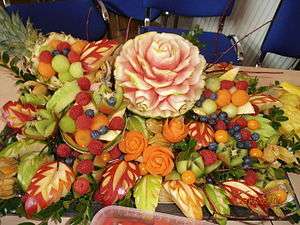Thai fruit carving

Thai fruit carving is a traditional Thai art that requires neatness, precision, meditation, and personal ability. Fruit carving persisted in Thailand as a respected art for centuries.[1] It was originally used only to decorate the tables of the royal family.[2]
History
Carving fruits and vegetables was a skill taught to women in the Thai royal palace.
One (now known to be apocryphal) legend holds that sometime before the Sukhothai era (Thai era from 1808-1824), a concubine named either Nopharmas (Thai Peerage) or Tao Srijulaluk (another name of Thai peerage) wrote a book entitled Tumrubtaosrijulaluk. The book discusses traditional Thai ceremonies, including the floating lantern festival called Prarajchapiteejoongprennaiwanpenduansibsong. Its protagonist wants to decorate a lantern more beautifully than other concubines, so she uses many kinds of flowers to decorate her lantern. Then she carved fruits into bird and swan shapes and placed them on the flower petals.[3]
Tools
Craftsman use only one knife to make the fantastic carving fruit, although they come in many varieties.
- Knife
- Round handle Knife
- Plane handle Knife
- Crafting Knife
- Peeler
- Scoop
- Molding
- Scissor
- Cutting
- Water blow
- Plate for piece of waste fruit
- Napkin
- Food plastic cover
- Rubber gloves
Types of fruit
Many types of fruits are used for carving. The two basic types are thick fruit and thin.[3]
- Carrot
- Cucumber
- Tomato
- Radishes
- Chili
- Taro
- Pumpkin
- Ginger
- Lemon
- Leek
- Onion
- Lettuce
- Cabbage
- Beetroot
- Apple
- Papaya
- Guava
- Pineapple
- Cantaloupe
- Watermelon
- Yam
- Mango
- Rose apple
- Sapodilla
- Monkey apple
- Dragon fruit
References
- ↑ McDermott, Nancie (4 May 2012). Real Thai: The Best of Thailand's Regional Cooking. Chronicle Books. pp. 11–. ISBN 978-1-4521-1646-4.
- ↑ Keller, Michael. More Living Thai Ways. Booksmango. pp. 169–. ISBN 978-616-7270-97-5.
- 1 2 History (n.d.). Retrieved July 2014, 25